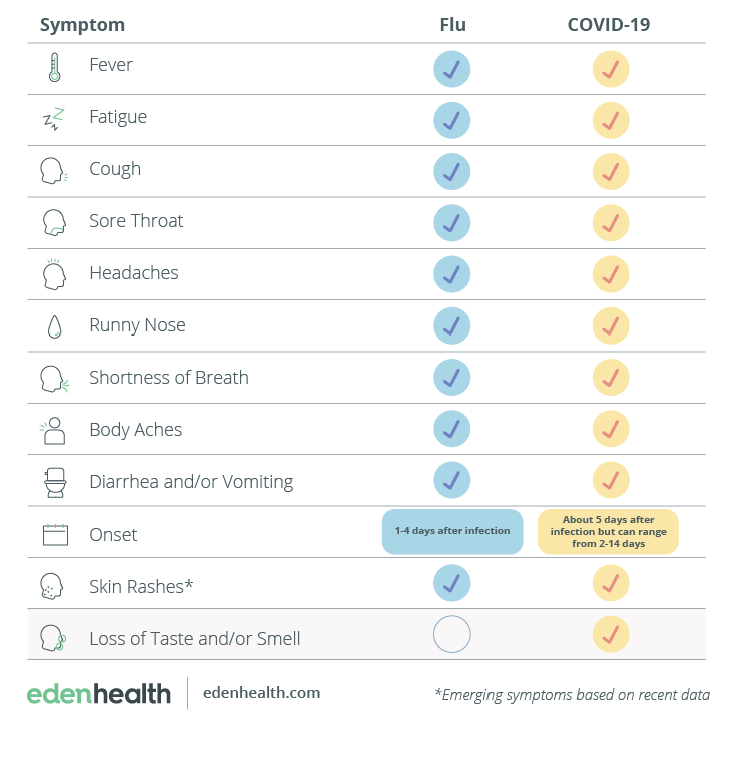Over a half a million people are hospitalized with the flu each year, and the combination of COVID-19 and influenza infections are predicted to overwhelm our health and hospital systems. As we head into what is anticipated to be a season of high risk for both COVID-19 and the flu, we want to help keep your employees as healthy as possible. In this blog post, we outline the latest information on both viruses to arm you with the knowledge you need going into the winter months, especially as some companies plan to execute back-to-work initiatives during this risky time.

As the colder months arrive each year and more people congregate indoors, the danger of catching and spreading the flu is always high. But this year, COVID-19 poses an additional risk factor. This new virus has similar symptoms and infection vectors and poses an even greater threat to an individual’s health.
Since it is difficult to determine if you are sick with the flu or COVID-19 judging by symptoms alone, testing may be needed to confirm a diagnosis. To help protect you from the flu, we strongly recommend that all individuals get the flu vaccine this year. It will also help reduce the strain on public health resources, which are burdened every year with flu cases and will need added capacity to handle patients with COVID-19.
Here’s what you need to know about these two viruses.
Flu and COVID-19: How they’re alike.
- They are respiratory diseases, but caused by different viruses.
- Both are spread through close contact (within 6 feet) and mainly through droplets (coughing, sneezing, talking).
- Both can be spread by individuals touching surfaces and then touching their own nose, mouth, or eyes before washing their hands.
- Patients testing positive for the flu or COVID-19 may experience varying levels of symptoms (many symptoms, few symptoms, or none at all).
- Patients infected with the flu or COVID-19 can be contagious to others before showing any symptoms.
- Both can cause additional complications such as pneumonia, respiratory failure, acute respiratory distress syndrome (i.e. fluid in lungs), sepsis, cardiac injury such as heart attacks or stroke, multiple-organ failure, worsening of chronic medical conditions that involve the lungs, heart, nervous system or diabetes, inflammation of the heart, brain or muscle tissues, or secondary bacterial infections .
As shown in the table below, flu and COVID-19 have very similar symptoms, making it difficult to assess infection by symptoms alone.

New information about COVID-19 is being learned every day and this list may continue to vary. We will do our best to help educate our patients as new information becomes available.
Flu and COVID-19: How they’re different.
- With COVID-19, some people may have a symptom of loss of smell or taste. This has not been known to be a symptom of the flu or common cold.
- Different types of rashes can be symptoms of either COVID-19 or the flu.
- COVID-19 is more contagious and can spread more easily
- COVID-19 symptoms may take longer to present themselves. Flu symptoms usually appear 1-4 days after infection. COVID-19 symptoms typically develop about five days after being infected, but can appear as early as two days or as late as 14 days.
- Adults with the flu are contagious about a day before they show symptoms and remain contagious for about 7 days, being most contagious in the first 3-4 days. People with COVID-19 may be contagious for a longer period than that. More is still being learned about the novel coronavirus, but it is thought that people can be contagious 2 days before experiencing symptoms and remain contagious for at least 10 days after symptoms first appear, even if their symptoms go away.
- COVID-19 can also cause more serious complications than the flu such as blood clots (lungs, heart, legs, or brain), or multisystem inflammatory syndrome in children.
- At this writing, there is an approved vaccine for the flu but none for COVID-19.
- There are FDA-approved antiviral drugs to treat the flu but none for COVID-19. For the latter, however, remdesivir is being explored and can be used under Emergency Use Authorization only. Eden Health will continue to monitor the progress in this area and will provide more information as it becomes available.
- Most people with the flu recover in a few days to less than two weeks.
Flu and COVID-19: What to do if you get sick.
- Always err on the side of caution. To protect others and help slow the spread of these viruses, stay home if you feel sick.
- If you have symptoms, contact your doctor immediately. They will be able to determine if your symptoms warrant additional screening or testing.
- Only a test will be able to definitively confirm if you have COVID-19 or the flu. Be aware that you can contract the flu and COVID-19 at the same time, so you may need to be tested for both. Follow your doctor’s advice.
- Determine where you have been for the last 2-5 days and contact people you’ve been in physical proximity to.
- Contact your employer. In the event you are positive for COVID-19, your employer will be able to notify any employees you may have been in contact with in the 2-5 days prior to showing symptoms. If you have contracted the flu, your employer can let symptomatic employees know it may be the flu. They can contact their doctor for diagnostic testing to be sure.
Flu and COVID-19: How to protect yourself.
Here’s some good news: the habits you’ve probably developed in the past several months to stay safe from COVID-19 can also help to protect you from the flu.
- The best way to prevent getting the flu or COVID-19 is avoiding exposure altogether. As much as possible, limit time spent near other people and stay away from poorly ventilated indoor areas.
- Get your flu shot. It can take up to two weeks after receiving the flu shot for the antibodies to develop in the body. Research dictates what flu strains will be most common in the upcoming season and determines what antibodies need to be in the vaccine.
- Maintain 6 feet of distance from others. COVID-19 and the flu are mainly spread by droplets and being in close contact with others.
- Wear a mask. Be sure to wear a mask that covers your nose and mouth when you are around others. It is meant to protect other people in case you are infected since flu and COVID-19 symptoms may not present themselves for several days—or even at all.
- Wash your hands often, for at least 20 seconds using soap and water. Make sure to wash your hands before touching your face, preparing food, after leaving a public place, touching your mask, or using the restroom. If soap is not available, use hand sanitizer that contains at least 60% alcohol.
- Make sure to regularly disinfect frequently touched surfaces. These can include tables, doorknobs, light switches, countertops, handles, desks, phones, keyboards, toilets, faucets, and sinks. Clean with detergent or soap and water, then follow up by using a household disinfectant. You can find a list here of common EPA-registered household disinfectants.
- Check your temperature daily. Keep a constant watch for other symptoms such as fever, cough, shortness of breath or others listed above. This will help you detect any changes to your health earlier.
- The more you know about the viruses and how they spread, the more you can help protect you and your family from contracting the virus.
Eden Health prides itself on delivering the best care to our patients. As part of this mission, we use our blog as a way to provide helpful information to commonly asked questions and keep our readers informed on the latest news that could impact their health. Stay tuned as we continue to provide resources to improve the health and safety of our community.
To further enhance the health of your employee population, an integrated 360 care approach may be ideal. By combining attentive medical care, mental health care, and insurance navigation, this methodology ensures that employees get the attention, treatment, and support they need to stay healthy and productive. For more information, download Eden Health’s new guide, A 360 View: A Closeup Look at Integrated Care.





